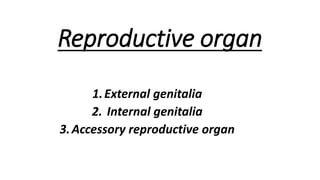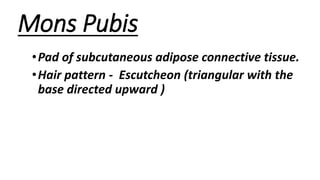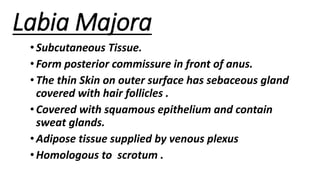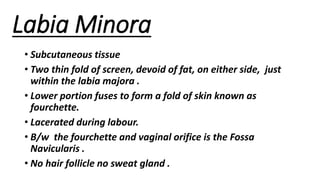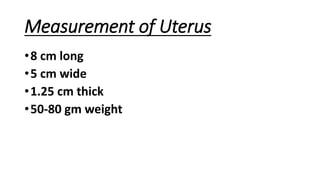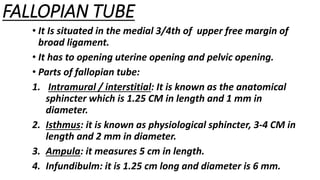Anatomy of female reproductive organ.pptx
- 1. Reproductive organ 1.External genitalia 2. Internal genitalia 3.Accessory reproductive organ
- 3. Vulva /pudendum (covered by keratinized startified squamous epithelium) ŌĆó Mons pubis ŌĆó Labia Majora ŌĆó Labia Minora ŌĆó Hymen ŌĆó Clitoris ŌĆó Vestibule ŌĆó Urethra ŌĆó Skin gland ŌĆó BartholinŌĆÖs gland ŌĆó Vestibular bulb
- 4. Mons Pubis ŌĆóPad of subcutaneous adipose connective tissue. ŌĆóHair pattern - Escutcheon (triangular with the base directed upward )
- 5. Labia Majora ŌĆóSubcutaneous Tissue. ŌĆó Form posterior commissure in front of anus. ŌĆó The thin Skin on outer surface has sebaceous gland covered with hair follicles . ŌĆó Covered with squamous epithelium and contain sweat glands. ŌĆó Adipose tissue supplied by venous plexus ŌĆó Homologous to scrotum .
- 6. Labia Minora ŌĆó Subcutaneous tissue ŌĆó Two thin fold of screen, devoid of fat, on either side, just within the labia majora . ŌĆó Lower portion fuses to form a fold of skin known as fourchette. ŌĆó Lacerated during labour. ŌĆó B/w the fourchette and vaginal orifice is the Fossa Navicularis . ŌĆó No hair follicle no sweat gland .
- 7. CLITORIS ŌĆó Small cylindrical erectile body, ŌĆó 1.5 - 2 cm situated in anterior part of vulva. ŌĆó It has three part ŌĆó Glance which is covered by squamous ŌĆó Body ŌĆó Crura
- 9. Vestibule ŌĆó It is made up Anteriorly by clitoris ŌĆó And posteriorly by forchette. ŌĆó It has four opening :- 1. Urethral opening 2. Vaginal orifice and hymen 3. Opening of birtholin duct 4. Skene's gland
- 10. Urethral opening: ŌĆó the opening is situated in the mid line just in front of vaginal orifice about 1.5 CM below the pubic arch.
- 11. Vaginal Opening ŌĆóIt is incompletely closed by a septum of mucus membrane called hymen. ŌĆóHymen lined by stratified squamous epithelium.
- 12. Bertholin Duct Opening ŌĆóIt is pea shaped and yellowish white in colour. ŌĆóDuring sexual excitement it secrete abundant alkaline mucus which help in lubrication.
- 13. SkenesŌĆÖs Gland ŌĆó The largest para urethral gland it is homologous to prostate.
- 14. UTERUS ŌĆóHollow pyriform muscular organ situated in pelvis is known as uterus. ŌĆóIt is situated between bladder and rectum.Position: antiversion and antiflexion. ŌĆóIt inclines to the right dextro rotation so that cervix is directed to the left levo rotation and come in closer relation with the left ureter.
- 16. Measurement of Uterus ŌĆó8 cm long ŌĆó5 cm wide ŌĆó1.25 cm thick ŌĆó50-80 gm weight
- 18. ŌĆó BODY ŌĆó It is also known as the Corpus ŌĆóBody is divided into 1. Fundus 2. Body cavity ŌĆóThe uterine tube, round ligament, ligament of the ovary, attached to it.
- 19. ŌĆóIsthmus :- it is constricted part measuring 0.5 CM between body and cervix. ŌĆó Cervix: it is cylindrical in shape and measure 2.5 CM.It extended from the isthmus and end at the external OS which open into vagina.The part lying above vagina is called Supra vaginal
- 20. STRUCTURES Body : 1.Perimetrium: It is a serous coat attached to the peritoneum. 2.Myometrium: it consists of a thick bundle of smooth muscles fibre. During pregnancy three layer can be identified outer longitudinal middle, interlacing inner circular. 3. Endometrium: it is known as decidua in pregnancy.It is mucus lining, it consists of lamina propria and surface epithelium.Lamina propria is the made up of instrumal cells endometrial glands and vessels.
- 21. Cervix ŌĆóIt is composed of fibrous connective tissue.Secretion is the endometrial secretion is scanty and watery.Alkaline thick rich in mucoprotein fructose and NaCl.
- 22. Arterial Supply ŌĆó Uterine arteries and vaginal arteries. ŌĆóInternal supply : basal artery and spiral artery . Veins : Internal iliac vein. NERVE : it get supply from sympathetic system and partially from parasympathetic system ŌĆóSympathetic is T5 ŌĆōT6, T10 ŌĆō L1 ŌĆóPara sympathetic: pelvic nerve S2 ,S3 and S4 ŌĆóThe uterus is developed from fused vertical part of two mullerian duct.
- 23. FALLOPIAN TUBE ŌĆó It Is situated in the medial 3/4th of upper free margin of broad ligament. ŌĆó It has to opening uterine opening and pelvic opening. ŌĆó Parts of fallopian tube: 1. Intramural / interstitial: It is known as the anatomical sphincter which is 1.25 CM in length and 1 mm in diameter. 2. Isthmus: it is known as physiological sphincter, 3-4 CM in length and 2 mm in diameter. 3. Ampula: it measures 5 cm in length. 4. Infundibulm: it is 1.25 cm long and diameter is 6 mm.
- 25. STRUCTURE it consists of three layer. 1. Serous: all side of peritoneum except the line of attachment of mesosalphinx. 2. Muscular: arranged in outer longitudinal and inner circular. 3. Mucous membrane: it has three different cell - ŌĆó Columnar ciliated epithelial cell ŌĆó Secretary columnar cell and ŌĆó Peg cell.
- 26. Function ŌĆó Transport of the gametes ŌĆó To facilitate fertilization ŌĆó And survival of zygote through secretion Blood supply: 1. arterial supply is from the uterine and ovarian. 2. Venous drainage is through pampiniform plexus into ovarian vein
- 27. OVARY Paired sex glands Function : Germ cell maturation, storage and release. Steroidgenesis Each glant is oval in shape and pinkish grey in colour. Surface is scarred during reproductive period. Size: 3cm ├Ś 2cm├Ś 1cm
- 29. ŌĆó Ovary has two end :- tubal and uterine ŌĆó Has two border :- mesovarium and free posterior. ŌĆóIt has two surface:- media surface and lateral surface The structure: ŌĆóThe ovary is covered by single layer of cubical cell known as germinal epithelium. ŌĆó Cortex : strom cells which is thick beneath epithelium form a tunica albuginea. ŌĆó During reproductive period cortex cover follicle known as functional unit of the ovary.
